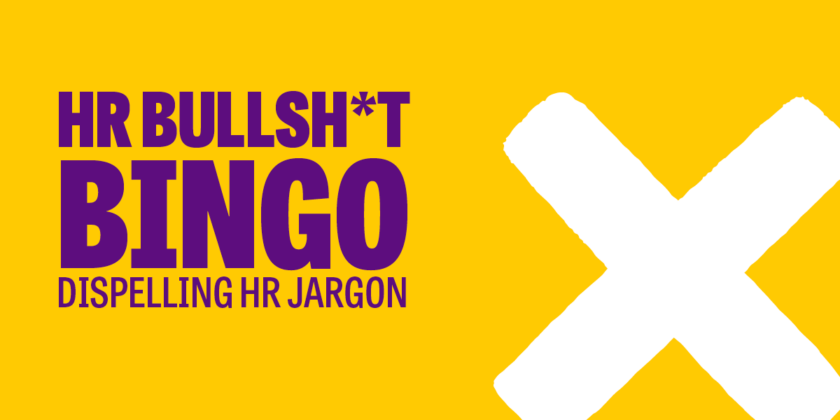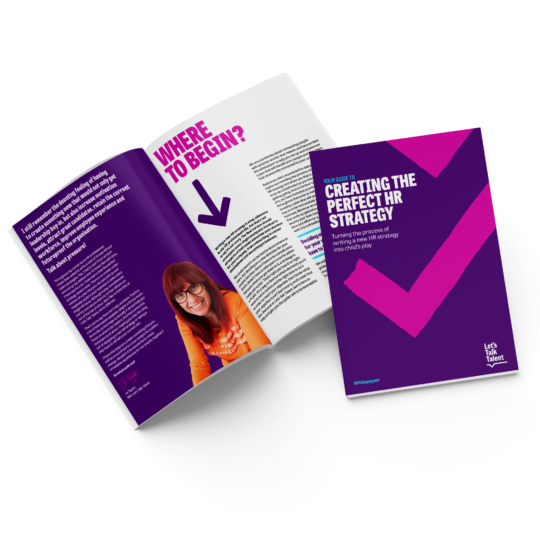Top HR terms every professional should understand
The HR industry has a clear mission: to help organisations attract, keep and grow great people.
To do this, we’ve developed a set of practices, guidelines and with time, our own language. So much so that we’ve got an entire glossary of terms that few truly master. Promotion, career progression, career pathways, career development… Are they all the same? Shouldn’t we just pick a lane and stick to it?
“We sometimes tend to speak our own language, and we could be at risk of both alienating some people, and diluting our efforts. It’s time we got back to basics” says Jo Taylor, MD at Let’s Talk Talent. LTT is here to dispel the HR jargon and, more importantly, make sure we all understand the actions that need to underpin these terms in order to create meaningful, targeted results.
1. Employee experience (EE)
Alternative HR terms used for employee experience:
- Candidate experience
- Customer experience
- People experience
- Employee Lifecycle
- Employee engagement
- Staff experience
- EVP
- EX
EE is the why, the what and the how of working for you. It is about creating the join up between every single touchpoint or interaction you’ll have with employees, and creating moments that matter. Ensuring each stage of their lifecycle is joined up is quite a tall order, of course, but clarity should be the main focus.
Your EE should tell people what they need to do to be successful within your organisation and cover:
- The WHAT (what it means to work for you, what is required, and what they will get in return)
- The HOW (the behaviours that are valued within your organisation, as well as how they will deliver the work, from your dress code to the hours they should keep)
- The WHY (your mission, your values, your objectives)
- The WHO (the relationships they will need to foster, such as their managers and the stakeholders they will be interacting with on a regular basis)
- The WHERE (their place of work, and whether you prescribe to the hybrid, in-person or remote way of working)
A great employee experience isn’t about having free snacks in the office or beers on Friday (read our blog on the bullsh*t behind employee experience here). Reviewing your employee experience involves constantly gathering insight and acting upon that insight to eliminate the points of friction along the way. We believe it starts from the first touchpoint to lasting memory. And at a time when candidates drive the market, isn’t it best to stand out?
2. Career progression
Alternative HR terms used for career progression:
- Career development
- Career management
- Career progression
- Career pathways
- Promotion
- Career possibilities
- Squiggly careers
This HR pillar has seen many iterations over the years, but the concept has remained the same: it’s all about helping people navigate their career. Many organisations are changing the way they look at careers from a linear process, with promotion as the only viable option to a more squiggly or horizontal pathway. But when it comes to career progression, what is required of HR teams? “It’s about showing people the world of possibilities,” says Jo. And ensuring it all links back to your performance management, L&D and succession planning strategies.
Development doesn’t have to be linear. It can be horizontal, squiggly, vertical… This could be done through internal mobility, mentoring, shadowing or deepening expertise. HR teams should ensure their definition of career progression is wide enough to provide the right opportunities for its people, whether they are on a specialist or management path, and then put the right resources and processes in place for them to explore their career with the organisation.
3. Employee empowerment
Alternative HR terms used for employee empowerment:
- Autonomy
- Accountability
- Ownership
- Motivation
Many organisations are realising that autonomy is a key employee retention lever. According to a PwC report, “Employees who feel they can act with autonomy in their day-to-day work environment tend to have stronger job performance, higher job satisfaction and greater commitment to the organisation. Nearly half of employees would give up a 20% raise for greater control over how they work.” But giving employees the autonomy to make decisions and to be accountable for their actions isn’t easy. It means providing them with the tools they need to grow within a psychologically safe space where they are allowed to make mistakes. “This is not a quick fix,” adds Jo. “And it’s worthless unless you’re willing to walk the walk and talk the talk.”
4. Diversity and inclusion (D&I)
Alternative HR terms used for diversity and inclusion:
- D&I, ED&I, DE&I
- Equality, Diversity & Inclusion
- Belonging
- Inclusive leadership
This one is currently being used a lot, which is great. But for us, it’s not about specific groups. It’s about making sure everyone in your organisation feels they can bring their whole self to work. It’s about creating a high trust culture, where every employee feels trusted to do their job well, and that they can in turn trust the organisation to recognise their contribution. As such, we don’t believe it should be a separate section of your HR strategy. D&I should be built into everything you do. It is about making diversity an integral part of your talent story, rather than a single vertical pillar, as there is then a risk that it will not mix well with other separate initiatives within your plan. And research shows doing so benefits organisations financially, as those with a diverse workforce make on average 19% more in revenue.
5. Organisational or cultural fit
Alternative HR terms used for cultural fit:
- Culture add
The famous: “They weren’t a good fit!” Whilst this term isn’t necessarily confusing as we’re all pretty much aligned on what it means, the concept of a good cultural fit can be a bit woolly and as such, lead to bias.
It’s true that a good fit is important, particularly during recruitment, but it can be hard to define what this looks like specifically. Unconsciously, we may even use the lack of ‘fit’ to reject certain candidates who do not match our own view of the world, creating a culture of mini-mes that isn’t conducive to innovation.
So how can managers ensure recruits are ‘a good fit’ without rejecting candidates based on nothing else but a vague sense of whether they’ll mix well? Blind hiring is a good start. Remove key information from resumes before passing them on to managers. Then, create multi disciplinary interview panels bringing together key members of several teams with varied opinions. A good cultural fit is important, but it is even more crucial to ensure you make impartiality an integral part of how you hire.
6. Work-life balance
Alternative HR terms used for work-life balance:
- Wellbeing
- Health & Wellbeing
- Hybrid working
- Flexible working
- Rest
What does providing employees with a good work-life balance entail? In simple terms, it’s about allowing people to unplug. There is a lot of talk on how best to look after employees and their wellbeing. While the word is all the rage, the famous work-life balance remains an elusive myth. According to Jo, we’re yet to crack this one.
“The fundamental problem is that there aren’t enough people to do the work, and staff are overwhelmed. Managers are buried under tons of admin, and no matter how much we spend on time management courses or Friday lunchtime yoga classes, that’s not going away.”
Despite employee wellbeing being top of mind for everyone, people are even more stressed than they were at the peak of the pandemic. The cost of living, excessive workload, lack of support from managers, the hybrid model… “We’re setting people up to fail. Achieving a good work-life balance is really hard,” says Jo. So how can HR teams put meaningful measures into place? Promote several types of rest, not just time off, and research what others are doing in this area so you can better support your employees.
Are HR terms full of hot air?
There are many more terms we could explore in more detail, but the main point remains the same: no matter what you’re implementing, putting people at the core of everything you do is the most important thing to remember. While it’s fantastic that organisations are now talking about mental health, rest and ED&I, it’s even more important for HR teams to ensure these concepts are not viewed as quick fixes.
Each of the terms explored require years of effort and a complete culture change in order to bring about the kind of results that organisations are hoping to see. Whilst it’s important that we agree on the meaning of each of these terms, even more important are the actions behind these words. But as long as HR teams are open to change and continue finding innovative ways to attract, keep and grow great people, the best is yet to come!
If you’d like a fresh pair of eyes over your HR strategy or to ensure you are putting your HR efforts in the right place, don’t hesitate to book a call with us. Alternatively, have a look at our HR strategy services page for some additional resources.
Related Content:
- How L&D can improve your employee experience [Blog]
- Future-proof your business through diversity [Blog]
- The importance of Equality, Diversity and Inclusion (ED&I) in the workplace [Blog]
- Self-care and wellbeing tips for HR professionals over the summer break [Blog]
- Championing Neurodiversity: Practical Tips from Mel Francis [Podcast]
- The big list of HR Definitions – our HR Glossary [Free Resource]

